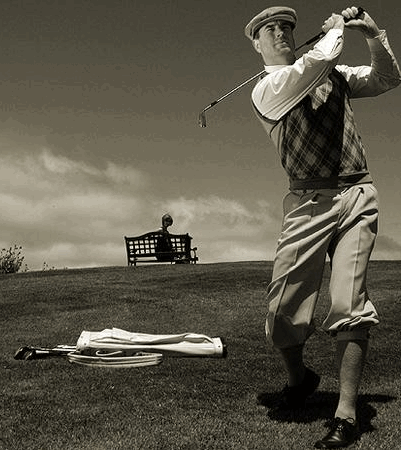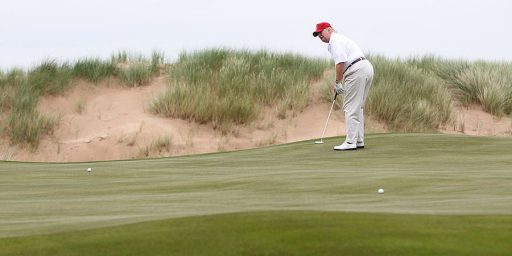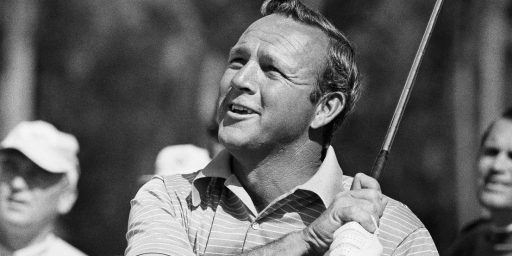Americans Giving Up Golf
 America’s love affair with golf has been fading with fewer men willing to devote a huge slice of their free time to the sport, forcing club owners to scramble for new ways to hook customers.
America’s love affair with golf has been fading with fewer men willing to devote a huge slice of their free time to the sport, forcing club owners to scramble for new ways to hook customers.
“We have to change our mentality,” said Richard Rocchio, a public relations consultant. “The problem is time,” offered Walter Hurney, a real estate developer. “There just isn’t enough time. Men won’t spend a whole day away from their family anymore.”
William A. Gatz, owner of the Long Island National Golf Club in Riverhead, said the problem was fundamental economics: too much supply, not enough demand.
The problem was not a game of golf. It was the game of golf itself.
Over the past decade, the leisure activity most closely associated with corporate success in America has been in a kind of recession. The total number of people who play has declined or remained flat each year since 2000, dropping to about 26 million from 30 million, according to the National Golf Foundation and the Sporting Goods Manufacturers Association. More troubling to golf boosters, the number of people who play 25 times a year or more fell to 4.6 million in 2005 from 6.9 million in 2000, a loss of about a third. The industry now counts its core players as those who golf eight or more times a year. That number, too, has fallen, but more slowly: to 15 million in 2006 from 17.7 million in 2000, according to the National Golf Foundation.
The five men who met here at the Wind Watch Golf Club a couple of weeks ago, golf aficionados all, wondered out loud about the reasons. Was it the economy? Changing family dynamics? A glut of golf courses? A surfeit of etiquette rules — like not letting people use their cellphones for the four hours it typically takes to play a round of 18 holes?
Or was it just the four hours?
[…]
The disappearance of golfers over the past several years is part of a broader decline in outdoor activities — including tennis, swimming, hiking, biking and downhill skiing — according to a number of academic and recreation industry studies.
[…]
But golf, a sport of long-term investors — both those who buy the expensive equipment and those who build the princely estates on which it is played — has always seemed to exist in a world above the fray of shifting demographics. Not anymore.
Jim Kass, the research director of the National Golf Foundation, an industry group, said the gradual but prolonged slump in golf has defied the adage, “Once a golfer, always a golfer.” About three million golfers quit playing each year, and slightly fewer than that have been picking it up. A two-year campaign by the foundation to bring new players into the game, he said, “hasn’t shown much in the way of results.”
[…]
Surveys sponsored by the foundation have asked players what keeps them away. “The answer is usually economic,” Mr. Kass said. “No time. Two jobs. Real wages not going up. Pensions going away. Corporate cutbacks in country club memberships — all that doom and gloom stuff.”
[…]
At the meeting here, there was a consensus that changing family dynamics have had a profound effect on the sport. “Years ago, men thought nothing of spending the whole day playing golf — maybe Saturday and Sunday both,” said Mr. Rocchio, the public relations consultant, who is also the New York regional director of the National Golf Course Owners Association. “Today, he is driving his kids to their soccer games. Maybe he’s playing a round early in the morning. But he has to get back home in time for lunch.”
Steven Taylor and I managed to play nine holes just about every week when we were teaching together and had the luxury of a cheap university course within half a mile of our offices. But I’ve hardly played since leaving academia. Finding the time is difficult.
While our lifestyles are almost immeasurably more comfortable than most experienced generations ago, they’re different. We’re seldom truly off work, even on weekends or vacations; that’s the nature of the information age. We’re simply expected to be within Blackberry reach during waking hours.
It may be that the pastimes of yesteryear will simply fade away as a result of this changed consciousness.
We can find a few minutes to play video games, taking a quick mental break. But to change into golf gear, drive out to the course, hit a bucket off the practice range, and spend four hours playing 18 holes? Let alone coordinating to find a partner or three, all of whom have to be able to do these things at the same time?
While I still follow baseball, for example, I don’t have time to watch 162 two-and-a-half hour games and the passion’s not the same if you just catch a game now and again. Its appeal is the slow evolution of a long season. Even great teams will lose fifty or sixty games a year, so none of them matter all that much, but the drama is the off chance that you might see something truly special.
Football, by contrast, is an event rather than a pastime, with a relative handful of games that are action packed and crucial to the success of a season. It has long since become our most popular spectator sport.
Photo via photo.net






How ’bout the constant increase in the cost of a round of golf? It’s hard to attract new golfers when you price yourselves out of the reach of the average wage earner.
I’m not sure “the average wage earner” was ever golf’s target audience.
Yeah, I have a similar problem.
An eight-hour session of Dungeons & Dragons just isn’t feasible for a 39-year-old lawyer and father of two.
The lack on interest by Americans for golf can be seen via the lack of twenty something winners on the PGA tour. Charles Howell III is almost universally declared best 29 and under American on the PGA Tour. Tour resume- 2 wins.
For ladies professional golf, the fall off in interest is no where nearly as strong. You have Pressel, Castrale, Gulbis, Creamer, Michelle Wie(who shot 69 yesterday), Christina Kim, Prammanasudh, Francella, and more. Defending US Open champ Cristie Kerr turned 30 after winning the open. More women are coming up, notably Korean-American golfers. Jane Park finished second at the SBS Open last weekend. Wie everyone knows of, but how about Kimberly Kim, Vicki Hurst, and I could list more.
Tiger Woods has had a huge financial impact on pro golf, but excite interest in the sport? Only so far as bringing more television viewers, not players of the sport.
On the other hand Se Ri Pak has inspired scores of women in both South Korea and the US to take up the game. That’s why I say the Korean golf queen may have more impact than anyone else on pro golf today. Look around, there are over 40 South Korean women on the LPGA. At least 35 of whom would testify Se Ri was their inspiration.
Look out for Ji Yai Shin in 2009. She has been demolishing the KLPGA for two years.
Bill
That’s why I’m starting in astronomy again. Put the kids to bed and get a hour or so of solitude staring at the sky before I head to bed.
I blame Bush. Just look at the dates. Can’t you see that Bush is just trying to wreck the golf industry. The only problem is I haven’t figured out why. But it is quite obviously Bush’s fault.
I blame golf course designers. The two most recently built courses in my neck of the woods (john Fought and Robert Trent Jones designs) are so frickin hard it takes the fun out of play. The greens are so fast putting off of them is common. The rough so penalizing you either lose the ball or waste a couple of strokes getting out. The length of the courses require huge drives followed by long irons into the green.
With the pros playing 230 yard par threes, 500 yard par fours and 600 yard par fives, new courses emulate what we see on TV not what a local player would enjoy. Instead of 6900 yard courses we need 6100 yard courses for a more enjoyable round and faster play. Wide fairways and little rough would lessen lost balls. Slower greens could cut the three and four putts. While we’re at it sexier cart girls.
Gee,
Last time I played a round of golf I plunked down $60 for 18 holes, received several disdainful glances at my lack of proper golfing attire, and then was subsequently rushed for 18 holes to make sure my group’s pace of play was fast enough. I haven’t had that much fun since getting a cap put on my tooth. I can’t imagine why golf may not be appealing to a younger generation…
Personally, I very seldom play an 18 hole course. There just isn’t time and my game falls off around the 13th to 15th hole. I play a 9 hole course voted one of the best in the USA and for only $13. I walk the whole course in 2.5 hours. I also practice on a 9 hole par 3 course for $6.00. I just love the game and won’t play with people or at places who don’t know how to enjoy it.
I’m the demographic that’s expected to play golf (affluent white male).
The first (and last) time was as a guest at West Point. Very difficult course (especially for a first-timer) and….. rude people.
I don’t see any point/fun in paying for golf lessons for the right to play with rude people.
How many other people have been turned off by the “attitude” at golf courses?
On the cost issue:
* Environmentalists, who have been making life for Course owners problematic at best.
* NIBMY, and the local zoning boards. Nuff said.
* Insurance, particularly liability.
* Taxes. Zoning a Golf Course “Commercial”. Think that’s going to raise the operating costs?
* Energy costs, in maintaining the place